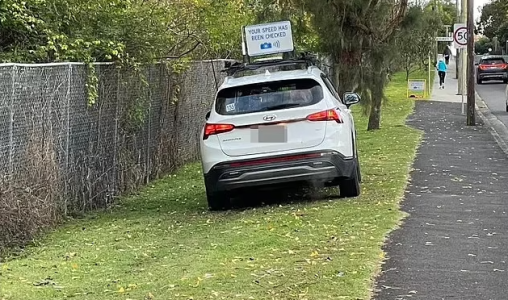You won't believe where this sneaky speed camera operator was caught hiding! See the outrageous photo inside!
By
- Replies 9
In a world where every second counts and every kilometre per hour over the limit can cost you, the sight of a speed camera can make any motorist's heart skip a beat. But it's not just the flash of the camera that's causing a stir in Sydney's Upper North Shore; it's the location of the sneaky operator and the damage they've left behind.
A mobile speed camera operator has sparked a wave of outrage after being caught parking on a nature strip in Lindfield, leaving behind unsightly tyre marks on the once-pristine lawn. The incident has fuelled a fiery debate among residents, who are not only concerned about the aesthetics but also about the broader implications of such actions.
The contentious photo, which circulated on Facebook, shows the vehicle – tasked with detecting speeding motorists – perched awkwardly on the sodden grass, tyre tracks marring the greenery. The recent heavy rains only exacerbated the damage, turning the nature strip into a muddy mess.
The community's reaction was swift and severe, with social media becoming the battleground for frustrated locals. 'How do we stop these speed checking cars from parking on the green verge,' demanded one resident, echoing the sentiment of many who believe that the law should not excuse such disregard for public property.
Another chimed in, 'Surely they can check our speed from a legally parked car on the road.' This comment highlights a broader issue that has been a thorn in the side of many Australian drivers: the perceived sneakiness of mobile speed camera operations.
The controversy doesn't stop at tyre tracks. Residents have also voiced their annoyance over the strategic placement of speed cameras, often claiming they are hidden behind parked cars or obscured by bins on the kerbside, making them difficult to spot.
Transport for NSW has responded to the uproar, stating that mobile speed cameras 'can be moved around at different times and locations.' They assure the public that all approved sites for mobile speed camera operations have been carefully analyzed, taking into account crash history, work health and safety (WHS), and technical requirements.
Furthermore, under the Road Amendment (Miscellaneous) Rule 2020 of the Road Transport Act 2013, vehicles used for traffic enforcement, such as mobile speed cameras and transportable mobile phone detection cameras, are exempt from certain parking rules. This includes the liberty to operate from a nature strip or verge.
This exemption, according to a Transport for NSW spokesperson, is also designed to prevent motorists from parking too close to speed camera vehicles, which could potentially reduce their visibility and effectiveness.
Despite these explanations, the community's concerns remain. While safety on the roads is of paramount importance, many argue that it should not come at the cost of damaging public property or employing tactics that feel underhanded to everyday drivers.
With around 2,700 mobile speed camera sites available across NSW, it's a topic that's unlikely to disappear from the rearview mirror anytime soon.
 So, dear members of the Seniors Discount Club, what are your thoughts on this issue? Have you encountered similar situations in your local area? Do you feel that mobile speed cameras are a necessary tool for road safety, or do you believe there's a better way to manage speeding without causing collateral damage or inciting public ire? Share your experiences and opinions in the comments below – let's navigate this road together!
So, dear members of the Seniors Discount Club, what are your thoughts on this issue? Have you encountered similar situations in your local area? Do you feel that mobile speed cameras are a necessary tool for road safety, or do you believe there's a better way to manage speeding without causing collateral damage or inciting public ire? Share your experiences and opinions in the comments below – let's navigate this road together!
A mobile speed camera operator has sparked a wave of outrage after being caught parking on a nature strip in Lindfield, leaving behind unsightly tyre marks on the once-pristine lawn. The incident has fuelled a fiery debate among residents, who are not only concerned about the aesthetics but also about the broader implications of such actions.
The contentious photo, which circulated on Facebook, shows the vehicle – tasked with detecting speeding motorists – perched awkwardly on the sodden grass, tyre tracks marring the greenery. The recent heavy rains only exacerbated the damage, turning the nature strip into a muddy mess.
The community's reaction was swift and severe, with social media becoming the battleground for frustrated locals. 'How do we stop these speed checking cars from parking on the green verge,' demanded one resident, echoing the sentiment of many who believe that the law should not excuse such disregard for public property.
Another chimed in, 'Surely they can check our speed from a legally parked car on the road.' This comment highlights a broader issue that has been a thorn in the side of many Australian drivers: the perceived sneakiness of mobile speed camera operations.
The controversy doesn't stop at tyre tracks. Residents have also voiced their annoyance over the strategic placement of speed cameras, often claiming they are hidden behind parked cars or obscured by bins on the kerbside, making them difficult to spot.
Transport for NSW has responded to the uproar, stating that mobile speed cameras 'can be moved around at different times and locations.' They assure the public that all approved sites for mobile speed camera operations have been carefully analyzed, taking into account crash history, work health and safety (WHS), and technical requirements.
Furthermore, under the Road Amendment (Miscellaneous) Rule 2020 of the Road Transport Act 2013, vehicles used for traffic enforcement, such as mobile speed cameras and transportable mobile phone detection cameras, are exempt from certain parking rules. This includes the liberty to operate from a nature strip or verge.
This exemption, according to a Transport for NSW spokesperson, is also designed to prevent motorists from parking too close to speed camera vehicles, which could potentially reduce their visibility and effectiveness.
Despite these explanations, the community's concerns remain. While safety on the roads is of paramount importance, many argue that it should not come at the cost of damaging public property or employing tactics that feel underhanded to everyday drivers.
With around 2,700 mobile speed camera sites available across NSW, it's a topic that's unlikely to disappear from the rearview mirror anytime soon.
Key Takeaways
- A mobile speed camera operator has been blamed for damaging a lawn while parking on a nature strip in Sydney's Upper North Shore.
- Residents expressed their outrage on social media over the significant tyre marks left on the wet grass.
- Transport for NSW allows mobile speed cameras to be parked on nature strips under certain criteria, despite resident frustration.
- Mobile speed camera vehicles have a parking exemption in NSW Road Rules, aimed at ensuring visibility and preventing obstruction by other vehicles.








